French Bulldog
| French Bulldog | |||||||||
|---|---|---|---|---|---|---|---|---|---|
 | |||||||||
| Other names | Bouledogue français | ||||||||
| Common nicknames | Frenchies | ||||||||
| Origin | France[1] | ||||||||
| |||||||||
| |||||||||
| Dog (domestic dog) | |||||||||
The French Bulldog (French: bouledogue or bouledogue français) is a breed of domestic dog, bred to be companion dogs. The breed is the result of a cross between Toy Bulldogs imported from England, and local ratters in Paris, France, in the 1800s.[3] They are stocky, compact dogs with a friendly, mild-mannered temperament.[4][5]
The breed is popular as a pet: in 2020, they were the second-most popular registered dog in the United Kingdom,[6] and the second-most popular AKC-registered dog breed in the United States.[7] They were rated the third-most popular dog in Australia in 2017.[8] In 2019, in the United Kingdom, the French Bulldog had 375 export pedigrees[9] and a total of 33,661 registered dogs.[10] By comparison, the Labrador Retriever had over 36,700 dogs and the Cocker Spaniel fewer than 22,000.
History[]
Blood sports such as bull-baiting were outlawed in England in 1835, leaving these "Bulldogs" unemployed;[11] however, they had been bred for non-sporting reasons since at least 1800, so their use changed from a sporting breed to a companion breed. To reduce their size, some Bulldogs were crossed with terriers, ratter dogs from the "slums" of England. By 1850, the Toy Bulldog had become common in England and appeared in conformation shows when they began around 1860.[citation needed] These dogs weighed around 16–25 pounds (7.3–11.3 kg), although classes were also available at dog shows for those who weighed under 12 pounds (5.4 kg).[11]
At the same time, lace workers from Nottingham who were displaced by the Industrial Revolution began to settle in Normandy, France.[12] They brought a variety of dogs with them, including Toy Bulldogs.[13] The dogs became popular in France and a trade in imported small Bulldogs was created, with breeders in England sending over Bulldogs that they considered to be too small, or with faults such as ears that stood up. By 1860, there were few Toy Bulldogs left in England, such was their popularity in France, and due to the exploits of specialist dog exporters.[14]
The small Bulldog type gradually became thought of as a breed, and received a name, the Bouledogue Francais.[14] This Francization of the English name is also a contraction of the words boule (ball) and dogue (mastiff). The dogs were highly fashionable and were sought after by society ladies and Parisian prostitutes alike, as well as creatives such as artists, writers, and fashion designers.[14] The artists Edgar Degas and Toulouse-Lautrec are thought to have French Bulldogs in their paintings.[15] However, records were not kept of the breed's development as it diverged further away from its original Bulldog roots. As it changed, terrier stock had been brought in to develop traits such as the breed's long straight ears.[14]
- French Bulldog Paintings in 1800s

Painting of Frenchie by Henri Toulouse-Lautrec

Painting of French Bulldog by Toulouse-Lautrec
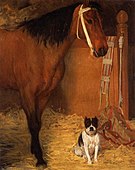
Painting of Horse and Dog by Edgar Degas

Painting of French bulldog by Toulouse-Lautrec
Breed clubs and modern recognition[]
Bulldogs were very popular in the past, especially in Western Europe. One of its ancestors was the English bulldog. Americans had been importing French Bulldogs for a while, but it was not until 1885 when they were brought over in order to set up an American-based breeding program. They were mostly owned by society ladies, who first displayed them at the Westminster Kennel Club Dog Show in 1896.[citation needed] They arrived again in the following year with even more entries, where the judging of the breed would go on to have future ramifications. The judge in question at the dog show, a Mr. George Raper, only chose winners with "rose ears"—ears that folded at the tip, as with the standard for Bulldogs.[16] The ladies formed the French Bull Dog Club of America and created the breed standard which stated for the first time that the "erect bat ear" was the correct type.[17]
In the early 20th century, the breed remained in vogue for high society, with dogs changing hands for up to $3,000 and being owned by members of influential families such as the Rockefellers and the J. P. Morgans. The American Kennel Club recognized the breed quickly after the breed club was formed, and by 1906 the French Bulldog was the fifth most popular dog breed in America.[18] In 2013, the American Kennel Club (AKC) ranked the French Bulldog as the 10th most popular breed in the United States, enjoying a sharp rise in popularity from 54th place a decade before, in 2003.[19] By 2014, they had moved up to become the ninth most popular AKC registered dog breed in the US and by the 2017 they were the fourth most popular.[7]
This new Bulldog breed arrived for the first time in England in 1893, with English Bulldog breeders in an uproar as the French imports did not meet the new breed standards in place by this time, and they wanted to prevent the English stock from crossbreeding with the French. The Kennel Club initially recognized them as a subset of the existing Bulldog breed rather than an entirely new breed.[14] Some English breeders in this period bred the French Bulldogs in order to resurrect the Toy Bulldog.[12] On 10 July 1902, at the house of Frederick W. Cousens, a meeting was held to set up a breed club in order to seek individual recognition for the French breed.[17] The adopted breed standard was the same one which was already in use in America, France, Germany and Austria.[12] Despite opposition from Miniature Bulldog (the new breed name for the Toy Bulldog) and Bulldog breeders,[20] in 1905, the Kennel Club changed its policy on the breed and recognized them separate from the English variety, initially as the Bouledogue Francais, then later in 1912 with the name changed to the French Bulldog.[17]
Historical photos of French bulldogs[]
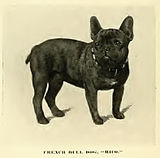
1890
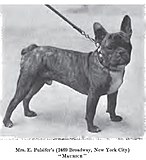
1901, Maurice in New York City
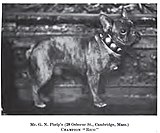
1901, Ch. Rico

1905, Diabutsu and Dimboola
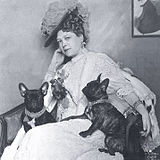
1908,
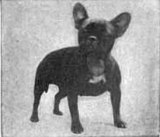
1911
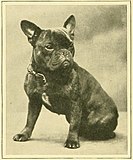
1911, Ch. Stanmore Argus
1915
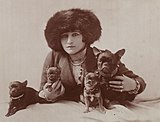
between 1875 and 1917
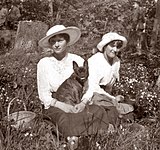
1917 with Grand Duchesses Tatiana and Anastasia Nikolaevna of Russia

Bulldog French
Description[]
The American Kennel Club standard for the French Bulldog states that it should be muscular, with a soft and loose coat forming wrinkles.[13]
The AKC Standard weight for a French Bulldog is maximum 28 pounds.[21] The head of a French bulldog should be square shaped and large, along with ears that symbolized bat ears.[21] French bulldogs are also known as a flat faced breed.[22] Eyes that are AKC Standard approved for French Bulldogs are dark and almost to the point of being black.[21] Blue eyed French bulldogs are not AKC approved.[21] The coat of a French bulldog should short haired and fine and silky.[22] Acceptable colors under the breed standard are the various shades of brindle, fawn, cream or white with brindle patches (known as "pied"). The fawn colors can be any light through red.[21] The most common colors are brindle, then fawn, with pieds being less common than the other colors.[23] The breed clubs do not recognize any other colors or patterns.[21] This is because some colors come linked with genetic health problems not usually found in the breed. These include blue coloration, which is linked with a form of alopecia (hair loss or baldness), sometimes known as "Blue Dog Alopecia".[24] Although this is heavily disputed by some organizations,[25] it has been suggested that the health, hair and skin conditions are caused by the color pigment (melanin) clumping in the hair shaft itself.[26] Even dogs that are not blue can develop "blue dog alopecia" or canine follicular dysplasia.
As of 2020, the long-hair gene in canines, also known as Fibroblast growth factor or "Fluffy" became more widely present in the French Bulldog population.[27] Breeders are working worldwide to create all of the coloured combinations of blue, chocolate, cream and spotting carrying the L4 gene.[28]
- French Bulldogs colors
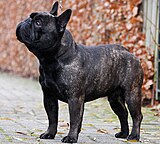
Brindle color

Pied Color

Cream Color

Fawn Color

Black color

Blue Color (not AKC approved)
Temperament[]
The French Bulldog, like many other companion dog breeds, requires close contact with humans. If left alone for more than a few hours, they may experience separation anxiety.[29][30] This is especially true when they are young, but persists into adulthood.[31] The French Bulldog is sometimes called a "Frog dog" or a "Clown dog." "Frog dog" is in reference to their wide round face and the way they sit with their hind legs spread out. "Clown dog" is because they are considered to be fun-loving, and indeed they have been described as the "clowns of the dog world."[32]
French Bulldogs are often kept as companions.[13] They rarely bark.[33] The breed is patient and affectionate with their owners, and can live with other breeds. French Bulldogs are agreeable dogs, and are human/people oriented dogs as this makes them on the easier side to train, even though they do have tendencies to be stubborn.[13]
They are ranked 109th in Stanley Coren's The Intelligence of Dogs.[34] There are certain exceptions to this average level of canine intelligence; a French Bulldog named Princess Jacqueline which died in 1934 was claimed to be able to speak 20 words, in appropriate situations.[35]
Health[]


As a consequence of selective breeding, French Bulldogs are disproportionately affected by health related problems.
Brachycephalic airway obstructive syndrome[]
The skull malformation brachycephaly was increased by breeding selection which led to the occurrence of the Brachycephalic airway obstructive syndrome. Therefore many French Bulldogs often pant sticking out their tongue even at slight efforts like walking.[36] The Brachycephalic syndrome causes them to have multiple side effects, as in difficulty breathing (which includes snoring, loud breathing).[37] It happens because they have narrow nostril openings, a long soft palate, and fairly narrow tracheas.[37] This issue can lead to death in French Bulldogs if they are not undergoing proper treatment.[37]
In order to treat these dogs and create a smoother airway to the lungs, a procedure must be done that takes out a portion of their soft palate.[37] The results of the procedure show a minimum of 60% better airway passage to the lungs.[37]
A UK breed survey report on 71 dog deaths put the average lifespan of French Bulldogs at 8 to 10 years, while the UK breed club suggests an average of 12 to 14 years.[38][37] The AKC lists that the French Bulldog breed has a lifespan of 11 to 13 years.[39]
In 2013, a UK Medical Study reviewed the health of 2228 French Bulldogs under veterinary care in the UK.[40] The study found that 1612 (72.4%) of these French Bulldog had at least one recorded health issue:[40] "The most common disorders recorded were ear infections (14.0%), diarrhea (7.5%) and conjunctivitis (3.2%). Skin problems were the most commonly reported group of disorders (17.9%). This study of over two thousand French Bulldogs provides a framework to identify the most important health priorities in French Bulldogs in the UK and can assist with reforms to improve health and welfare within the breed."[40]
[]
The French Bulldog has only a single short coat, which combined with their compromised breathing system, makes it impossible for them to regulate their temperature efficiently.[25] This means the dog may easily become cold, and are prone to heat stroke in hot and humid weather. French Bulldogs are also prone to allergies, which can cause eczema on the body.[41]
As they are a brachycephalic breed, French Bulldogs are banned by several commercial airlines due to the numbers that have died while in the air.[42] This is because dogs with snub noses find it difficult to breathe when they are hot and stressed. The temperature in a cargo space in an aircraft can rise as high as 30 °C (86 °F) when waiting on the runway.[43]
Birth and reproduction[]

French Bulldogs require artificial insemination and, frequently, Caesarean section to give birth, with over 80% of litters delivered this way.[44][45]
Back and spine[]
French Bulldogs are prone to having congenital hemivertebrae (also called "butterfly vertebrae"),[46][47] which will show on an X-ray.[48]
In October 2010, the UK French Bulldog Health Scheme was launched.[37] The scheme consists of three levels: the first level, Bronze, designates a basic veterinary check which covers all the Kennel Club Breed Watch points of concern for the breed. The next level, Silver, requires a DNA test for hereditary cataracts, a simple cardiology test, and patella grading. The final level, Gold, requires a hip score and a spine evaluation. The European and UK French Bulldog fanciers and Kennel Clubs are moving away from the screw, cork-screw or 'tight' tail (which is an inbreed spinal defect),[49] and returning to the short drop tail which the breed originally had.[50] The UK breed standard now states that the tail should be "undocked, [delete 'very'] short, set low, thick at root, tapering quickly towards tip, preferably [delete 'either'] straight, [delete 'or kinked'] and long enough to cover anus. Never curling over back nor carried gaily."[51]
The French Bulldog may develop .[52]
In popular culture[]
This article appears to contain trivial, minor, or unrelated references to popular culture. (June 2020) |
Dog Show history[]
While no French Bulldogs have been Best in Show at either Crufts or the Westminster Kennel Club Dog Show, during the 1950s a French Bulldog won Best of Breed for eight years in a row at Westminster; the run ended with the dog's retirement after the 1960 show.[53] The dog's owner, Amanda West, went on to win Best of Breed with other French Bulldogs for a further 10 years.[54] In 2010, a Canadian French Bulldog became the first of his breed to win the Non-Sporting Group[55] and make it through for consideration at the Best in Show round, eventually losing to a Scottish Terrier, Roundtown Mercedes of Maryscot.[56]
French bulldogs in events[]
The only French Bulldog aboard the RMS Titanic went down with the ship on 15 April 1912. First class passenger Robert Williams Daniel, a 27-year-old banker, had purchased the dog, named Gamin de Pycombe, for £150 (the equivalent of $17,000 in today's prices). A surviving passenger said that they had seen a French Bulldog swimming in the ocean after the ship sank.[57][58]
See also[]
- Dogs portal
- List of dog breeds
- Pug
References[]
- Specific
- ^ "Official standard from FCI (The Fédération Cynologique Internationale is the World Canine Organisation. It includes 91 members and contract partners (one member per country) that each issue their own pedigrees and train their own judges)", 'Official standard from FCI.'
- ^ "French Bulldog breed summary". AKC. Retrieved 19 July 2021.
- ^ "Le bouledogue Français, Ses origines", 'Official breed club created in 1898 (fr)'
- ^ O'Connell, Rebecca (18 November 2018). "11 Facts About French Bulldogs". mentalfloss.com. Retrieved 23 June 2020.
- ^ "Life with a French Bulldog". petcoach.co. Retrieved 23 June 2020.
- ^ "Top Twenty Breeds In Registration Order For The Years 2018 And 2019" (PDF). The Kennel Club (UK). Retrieved 23 June 2020.
- ^ Jump up to: a b "AKC: Most Popular Dog Breeds of 2018". The American Kennel Club.
- ^ "Top 10 dog breeds in Australia 2017. Don't worry, they're all adorable". NewsComAu. Retrieved 12 April 2017.
- ^ "UK Export Pedigrees Issued in 2019" (PDF). The Kennel Club.
- ^ "COMPARATIVE TABLES OF REGISTRATIONS FOR THE YEARS 2010 - 2019 INCLUSIVE" (PDF). The Kennel Club UK.
- ^ Jump up to: a b Coile (2005): p. 5
- ^ Jump up to: a b c Leighton (1907): p. 58.
- ^ Jump up to: a b c d "Get to Know the French Bulldog", The American Kennel Club, retrieved 28 May 2014.
- ^ Jump up to: a b c d e Coile (2005): p. 6
- ^ "French Bulldog Dog Breed Information". American Kennel Club. Retrieved 31 January 2020.
- ^ "History of the FBDCA". French Bull Dog Club of America. Retrieved 2 January 2019.
- ^ Jump up to: a b c Coile (2005): p. 7
- ^ Coile (2005): p. 8
- ^ American Kennel Club 2013 Dog Registration Statistics Historical Comparisons & Notable Trends, The American Kennel Club, Retrieved 28 May 2014
- ^ Leighton (1907): p. 59
- ^ Jump up to: a b c d e f Club, American Kennel. "American Kennel Club - Dog Breed Standards" (PDF).
- ^ Jump up to: a b "French Bulldog AKC".
- ^ American Kennel Club (11 November 2014). The New Complete Dog Book: Official Breed Standards and All-New Profiles for 200 Breeds, 21st Edition. i5 Publishing. p. 912. ISBN 9781621870913.
- ^ "Introducing the French Bulldog". French Bulldog Club of England. Archived from the original on 6 August 2011. Retrieved 14 October 2011.
- ^ Jump up to: a b "10 Things You Didn't Know about the Blue French Bulldog". 13 October 2014.
- ^ "Color Dilution Alopecia". Dermatology For Animals. Archived from the original on 3 June 2015. Retrieved 1 June 2015.
- ^ Housley, D. J. E.; Venta, P. J. (August 2006). "The long and the short of it: evidence that FGF5 is a major determinant of canine 'hair'-itability". Animal Genetics. 37 (4): 309–315. doi:10.1111/j.1365-2052.2006.01448.x. ISSN 0268-9146. PMID 16879338.
- ^ "Store - Orivet". www.orivet.com. Retrieved 9 March 2021.
- ^ "French Bulldog". PetDt Quickview. Retrieved 28 October 2018.
- ^ McCrave, Elizabeth A. (March 1991). "Diagnostic Criteria for Separation Anxiety in the Dog". Veterinary Clinics of North America: Small Animal Practice. 21 (2): 247–255. doi:10.1016/S0195-5616(91)50030-9. PMID 2053248.
- ^ Schwartz, Stefanie (June 2003). "Separation anxiety syndrome in dogs and cats" (PDF). Journal of the American Veterinary Medical Association. 222 (11): 1526–1532. doi:10.2460/javma.2003.222.1526. PMID 12784957. S2CID 37324864. Archived from the original (PDF) on 15 February 2020.
- ^ "French Bulldog Breed: Fun Loving Clown".
- ^ "French Bulldog Dog Breed Information". American Kennel Club. Retrieved 19 September 2020.
- ^ Coren, Stanley (2006). The Intelligence of Dogs. London, UK: Pocket Books. p. 124. ISBN 978-1-4165-0287-6.
- ^ "French Bulldoge That Could Talk Dies of Pneumonia". Telegraph Herald. Woodward Communications, Inc. 16 October 1934. Retrieved 14 October 2011.
- ^ Pet Health Network: Brachycephalic Syndrome
- ^ Jump up to: a b c d e f g "The French Bulldog – Statement of The Health of The Breed". French Bulldog Club of England. Retrieved 1 June 2015.
- ^ "Summary results of the Purebred Dog Health Survey for French Bulldogs" (PDF). Kennel Club/ British Small Animal Veterinary Association Scientific Committee. Retrieved 4 April 2011.
- ^ "French Bulldog Care". American Kennel Club. Retrieved 3 June 2015.
- ^ Jump up to: a b c "Demography and disorders of the French Bulldog population under primary veterinary care in the UK in 2013" https://cgejournal.biomedcentral.com/articles/10.1186/s40575-018-0057-9#Sec4
- ^ "French Bulldog". 2Puppies. Retrieved 25 November 2018.
- ^ Haughney, Christine (6 October 2011). "Banned by Many Airlines, These Bulldogs Fly Private". New York Times. Retrieved 8 October 2011.
- ^ White, Madeleine (7 October 2011). "Why are cute, snub-nosed dogs being banned from flying?". The Globe and Mail. Phillip Crawley. Retrieved 14 October 2011.
- ^ Evans, Katy M.; Adams, Vicki J. (2010). "Proportion of litters of purebred dogs born by caesarean section". Journal of Small Animal Practice. 51 (2): 113–8. doi:10.1111/j.1748-5827.2009.00902.x. PMID 20136998.
- ^ Pete Wedderburn (6 April 2009). "Why do over 80 per cent of Bulldog births happen by caesarian section?". The Daily Telegraph. Archived from the original on 13 August 2011. Retrieved 5 August 2010.
- ^ "Hemivertebrae". Mar Vista Animal Medical Center. Archived from the original on 30 April 2015. Retrieved 21 December 2019.
- ^ "Genetic welfare problems of companion animals: Hemivertebrae". Universities Federation for Animal Welfare (UK). Archived from the original on 12 March 2015. Retrieved 21 December 2019.
- ^ "Hemivertebrae". Top Dog Animal Health. Retrieved 1 June 2015.
- ^ "Talking About Tails". French BulldogZ. Archived from the original on 7 June 2015. Retrieved 1 June 2015.
- ^ "The Kennel Club Dog Health Group, Annual Report 2013, SPECIAL FEATURE - FRENCH BULLDOGS" (PDF). The Kennel Club (UK). Retrieved 1 June 2015.
- ^ "About The French Bulldog Tail". Retrieved 1 June 2015.
- ^ "Skin fold dermatitis in dogs". PDSA.org. Retrieved 5 March 2021.
- ^ "Bulldog Extends Streak, Retirement Will End It". The New York Times. 9 February 1960.
- ^ "She's Top Dog Again This Year". The Owosso Argus-Press. Thomas E. Campbell. 10 February 1970. Retrieved 14 October 2011.
- ^ "Non-Sporting Group Results - All Winners of James F. Stebbins Trophy - WestminsterKennelClub.org". Archived from the original on 17 March 2013. Retrieved 21 December 2019.
- ^ "Scottish terrier takes Westminster dog show". CBC News Canada. 17 February 2010. Retrieved 14 October 2011.
- ^ Lynch 1992, p. 100.
- ^ "Frenchies and the Titanic". French Bulldog Club of America. Archived from the original on 31 December 2012. Retrieved 13 December 2012.
- General
- Coile, D. Caroline (2005). French Bulldogs. Hauppauge, N.Y.: Barron's. ISBN 978-0-7641-3031-1.
- Leighton, Robert (1907). The New Book of the Dog. London; New York: Cassell. ISBN 9781440089428.
- Lynch, Don (1992). Titanic: An Illustrated History. New York: Hyperion. ISBN 978-1-56282-918-6.
External links[]
| Wikimedia Commons has media related to French Bulldog. |
- Toy dogs
- Bulldog breeds
- Companion dogs
- Dog breeds originating in France
- FCI breeds




















